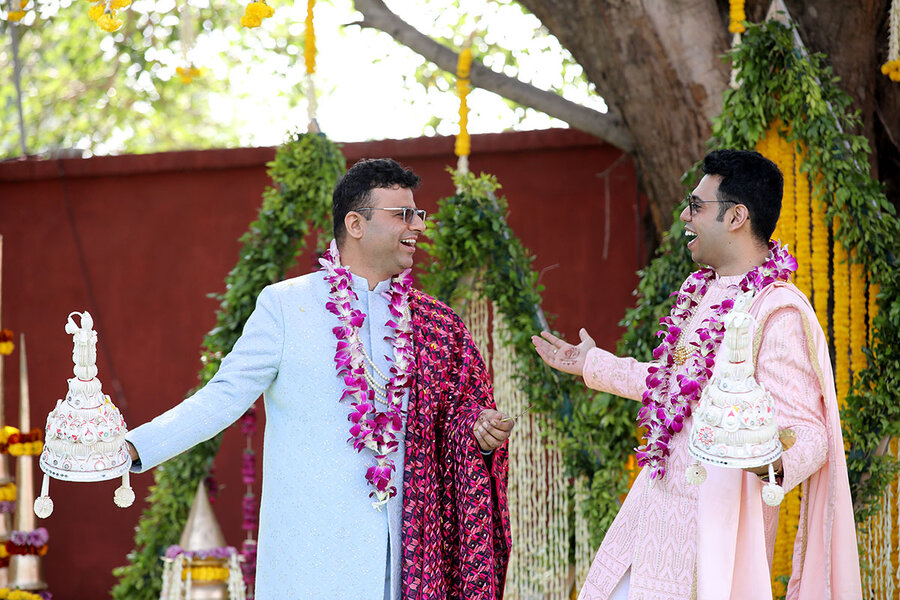To society, they’re married. To India’s courts, they’re roommates.
Loading...
When it was his turn to get married, Supriyo Chakraborty pulled out all the stops: spectacular fireworks, intricate floral decorations, beautifully coordinated outfits. The couple exchanged rings on a crisp winter night this past December in the southern Indian city of Hyderabad. It looked like any of the thousands of weddings taking place all over India at the time – except that Mr. Chakraborty was marrying a man.
Same-sex marriage is not legally recognized in India, but since the Supreme Court decriminalized homosexuality in 2018, LGBTQ couples have held weddings to make their relationship “official,” unofficially. These couples’ determination to get married, they say, is about breaking stereotypes, sharing their joy with friends and family, and insisting on access to a powerful cultural institution.
Why We Wrote This
Same-sex marriage is not legal in India, but queer couples are doing it anyway. Their drive to tie the knot – when there are no legal or financial incentives – is a reminder that marriage has always been more than a legal contract.
Around the world, ideas about what constitutes a family are expanding, but in India, marriage remains a given, says Amita Nigam Sahaya, author of the book “The Shaadi Story: Behind the Scenes of the Big Fat Indian Wedding.”
“We are weaned on the idea of getting married to somebody or the other,” she says. “All forms of culture – popular culture, traditional culture, familial culture, religiosity – all these talk about marriage as a part of an adult’s destiny.”
Growing up in a big family in eastern India, Supriyo Chakraborty frequently attended relatives’ lavish weddings. So when it was his turn, the hotel management lecturer pulled out all the stops: spectacular fireworks, intricate floral decorations, beautifully coordinated outfits. The couple exchanged rings under the stars on a crisp winter night this past December in the southern Indian city of Hyderabad. It looked like any of the thousands of weddings taking place all over the country at the time – except that Mr. Chakraborty was marrying a man.
Mr. Chakraborty and his husband, Abhay Dang, had lived together since 2013, and decided to get married last year. Same-sex marriage is not legally recognized in India, but since the Supreme Court decriminalized homosexuality in 2018, several LGBTQ couples have held weddings or wedding-like ceremonies to make their relationship “official,” unofficially.
These couples’ determination to get married, they say, is about breaking stereotypes, sharing their joy with friends and family, and insisting on access to a powerful cultural institution.
Why We Wrote This
Same-sex marriage is not legal in India, but queer couples are doing it anyway. Their drive to tie the knot – when there are no legal or financial incentives – is a reminder that marriage has always been more than a legal contract.
Around the world, ideas about what constitutes a family are expanding, but marriage and children remain common elements that many people – though not all – strive toward. This is especially true in India, where marriage is a given, says Amita Nigam Sahaya, author of the book “The Shaadi Story: Behind the Scenes of the Big Fat Indian Wedding.”
“We are weaned on the idea of getting married to somebody or the other,” she says. “All forms of culture – popular culture, traditional culture, familial culture, religiosity – all these talk about marriage as a part of an adult’s destiny.”
Married, but not on paper
Mr. Chakraborty and Mr. Dang’s nuptials had all the elements of a big fat Indian wedding and then some. Before the men exchanged vows, the officiant asked guests to stand up, raise their hand, and say “I do” to the couple as a way to express acceptance of their union. “There were a few people who raised both of their hands, and they were all shouting ‘I do,’” Mr. Chakraborty recalls. “Everybody was emotional.”
Mr. Chakraborty’s wedding made international headlines, but the couple hadn’t set out to make any statement, he says. They just wanted to celebrate their love openly.
“I wanted to call Abhay my husband,” Mr. Chakraborty says. “I didn’t want to say that I live with my friend.”
On paper, however, they might as well be just friends. Same-sex couples cannot register their marriage, meaning queer Indians are denied spousal rights that heterosexual couples enjoy and sometimes take for granted.
“I can’t make him a nominee to any of my property or vice versa,” says Mr. Chakraborty. “If I am hospitalized today, he is just a visitor for me because he can’t sign anything.”
Several petitions in courts across the country are pushing to change that. Many argue that by refusing to recognize the same-sex marriage, the government is depriving couples of their right to equality enshrined in the constitution.
In India, marriage is governed by a set of religious personal laws, which date back to the colonial era and vary among faiths, and a secular law called the Special Marriage Act. Both define marriage as a union of a man and a woman. “The law has that [gender] binary at the very heart of it,” says lawyer Akshat Agarwal. In fact, says Mr. Agarwal, all aspects of family law such as inheritance, guardianship, and protection from intimate partner violence imagine the family unit as a male-female pair. Recognizing same-sex couples would require an overhaul of that entire legal framework.
The government has squarely opposed such a change, arguing last year that recognizing same-sex marriages would cause “complete havoc with the delicate balance of personal laws in the country.”
Mr. Agarwal says marriage equality may take longer to achieve because of the country’s unique legal system. “While the argument for marriage is very clear, I think how you best do it is a little more complex in India,” he says.
In the meantime, couples are forging ahead, pursuing so-called social marriages until the courts recognize their nuptials.
The value of a social marriage
In India’s Silicon Valley of Bengaluru, Ankur Bhatnagar is scouting for a venue for his upcoming wedding. He wants to marry his longtime boyfriend in accordance with Hindu rituals, but he’s having trouble convincing priests to solemnize a gay marriage. One reason Mr. Bhatnagar wants to tie the knot is to smash stereotypes about queer relationships.
“There’s a perception that gay people are only interested in sex, but that’s not true,” says Mr. Bhatnagar. “We also have long, nurturing relationships like heterosexual couples.”
Marriage would also help validate his relationship in the eyes of society, he says. “In India, you feel incomplete if you’re not married.”
Same-sex social marriages are not a new phenomenon, says University of Montana Professor Ruth Vanita. In her book “Love’s Rite: Same-Sex Marriages in Modern India,” Professor Vanita documents stories of several lesbian couples who married in informal religious ceremonies across India since the 1980s. These couples were mainly working-class, non-English speakers who had no contact with the LGBTQ rights movement in the West.
“The desire to form long-term couples, for which marriage is one name, is found in all societies, going back to the ancient world,” she says via email, adding that marriage “is primarily a public statement about the importance of one’s union.”
In that sense, marriage can also be “a liberating act away from the secrecy, from the claustrophobia that is imposed on [LGBTQ people],” says Ms. Sahaya, who writes about India’s wedding culture.
Winds of change
It might be years before the Indian government recognizes same-sex marriage, but some private institutions are already moving in that direction. The company where Mr. Chakraborty’s husband works has been offering COVID-19 shots to employees’ families, including same-sex partners.
That acknowledgment turned a routine vaccination appointment into “a very, very proud moment for me,” says Mr. Chakraborty, “because somebody was recognizing that we are together.”
Last year, India’s Axis Bank announced a charter of LGBTQ-friendly policies for their employees and customers, such as allowing same-sex couples to open a joint bank account. One of India’s most popular matrimonial sites is reportedly looking to expand its services to the LGBTQ community. Movies featuring queer couples are also becoming more common in Bollywood.
Attitudes toward homosexuality are changing at the family level, too. Surabhi Mitra, a psychiatrist in central India, says her parents were “elated” when she told them about her girlfriend. The couple held a “commitment ring ceremony” last year and are now planning a beach wedding. In Mr. Bhatnagar’s case, it was his father, who comes from the conservative state of Haryana, who encouraged him and his boyfriend to get married. According to a Pew survey, acceptance of homosexuality in India increased by 22 percentage points between 2013 and 2019, among the largest shifts of the countries surveyed.
Mr. Agarwal, the lawyer, points out that the United States recognized same-sex marriage only after years of growing social acceptance, and he expects India will be the same.
Same-sex couples aren’t waiting though.
“We don’t need anyone’s permission to be happy,” says Mr. Chakraborty.









